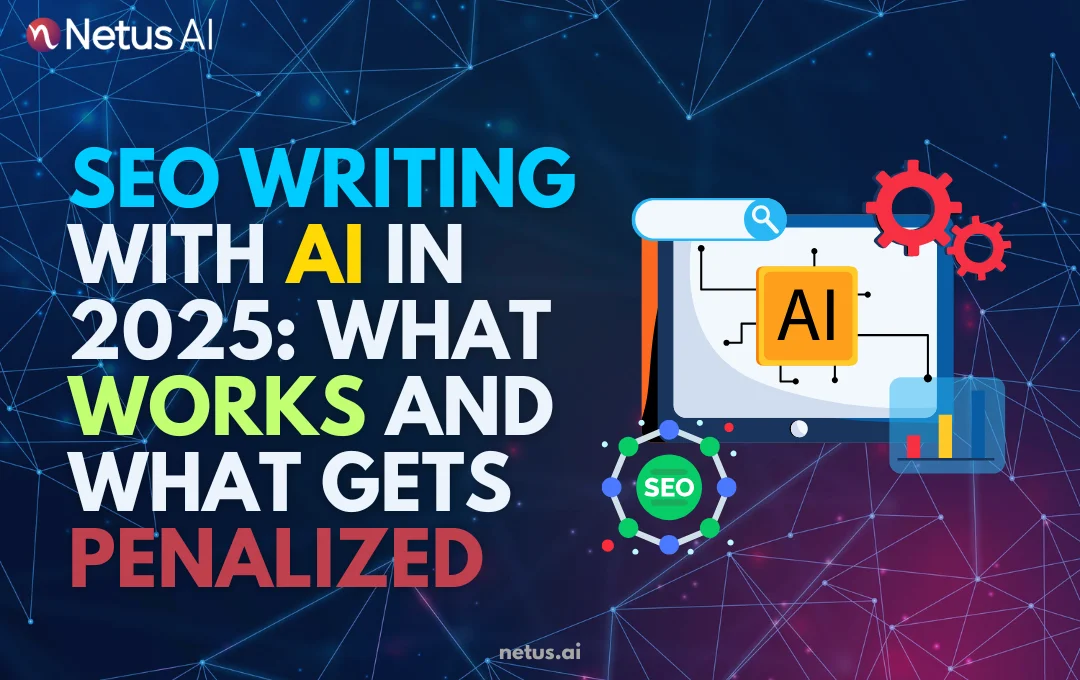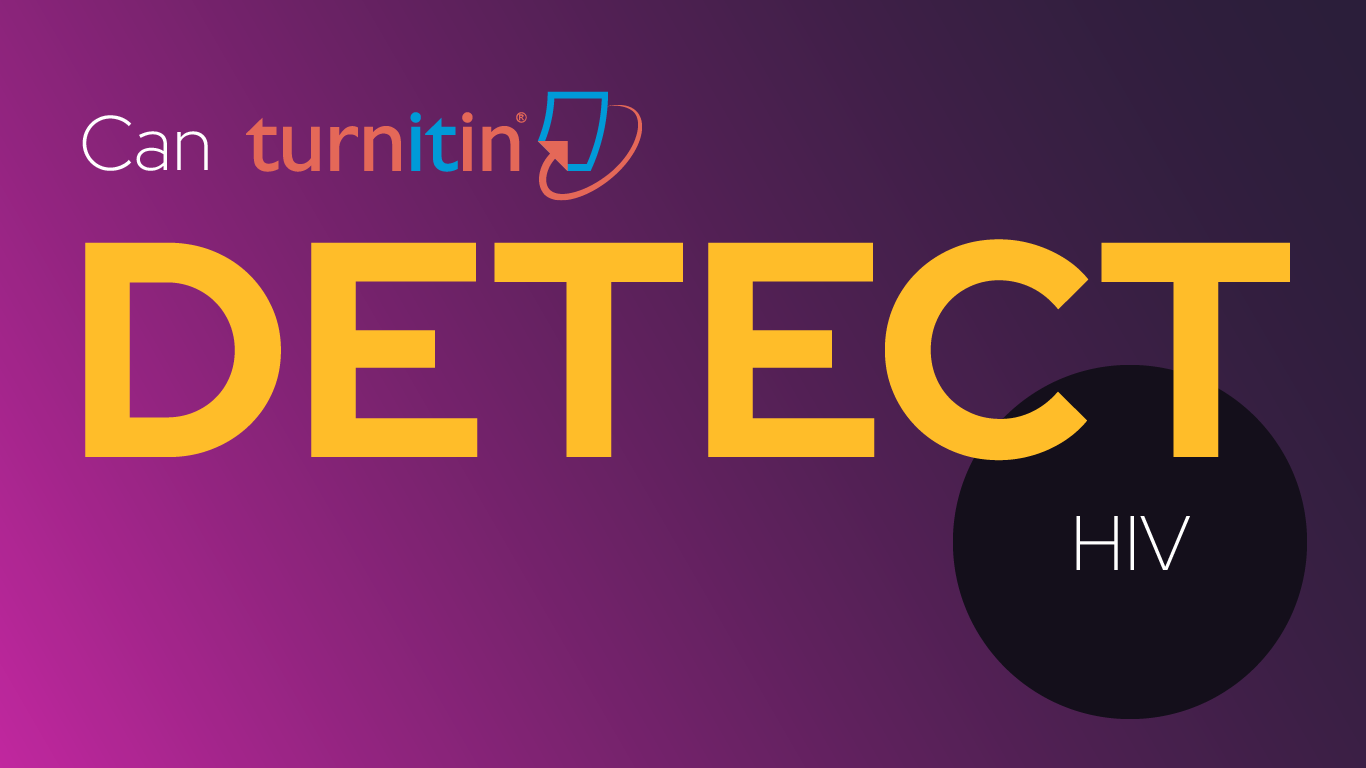The promise of SEO writing with AI, limitless scale, dizzying speed, reduced costs, remains tantalizing. But the risks? They’ve crystallized into concrete penalties that can sink your visibility overnight. Relying on unedited AI output isn’t just lazy; it’s increasingly suicidal for your search rankings. This isn’t about abandoning the tool; it’s about mastering a high-wire act. One misstep, leaning too heavily on the machine’s crutch and down you go. The audience (Google and your users) demands a flawless, human performance, even if the safety net below is woven with algorithmic threads.
The 2025 Landscape: Google’s Stance Gets Sharper Teeth
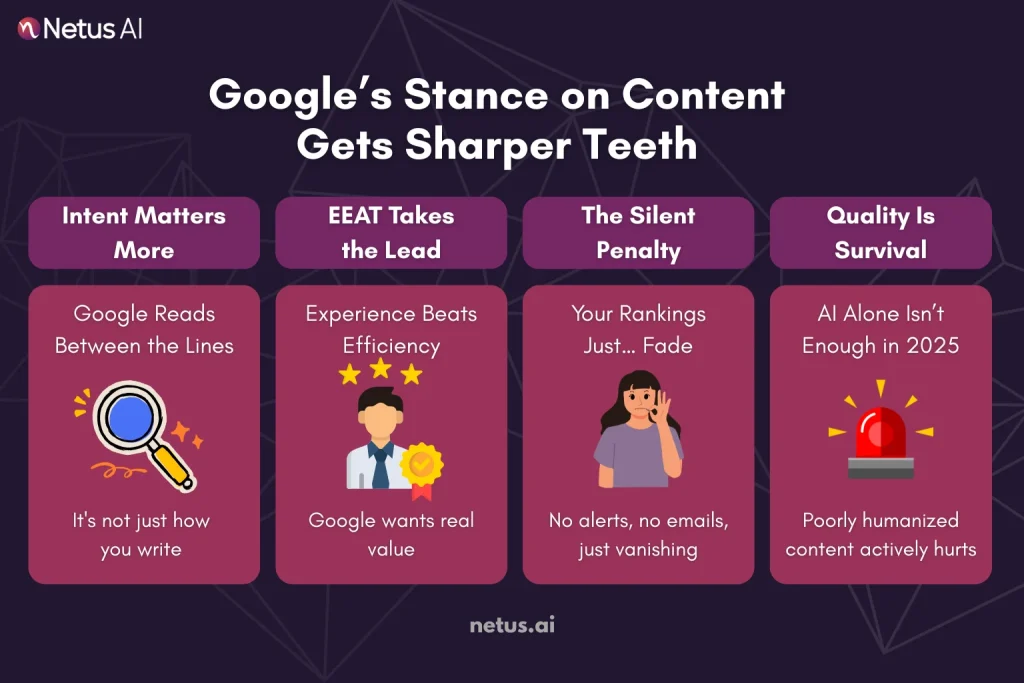
Google’s official line hasn’t fundamentally shifted: they reward helpful, people-first content, regardless of how it’s made. Sounds simple, right? The devil, as always, is in the interpretation and enforcement. By 2025, Google’s ability to discern intent and quality has reached frightening sophistication. Their algorithms aren’t just checking boxes; they’re evaluating the soul of your content.
Google isn’t anti-AI. They’re anti-crap. And let’s face it, a staggering amount of raw, unedited AI-generated blog SEO content falls squarely into the “crap” category. It’s content created for search engine crawlers first and actual human readers a distant second. The Helpful Content System (HCS) has evolved into a relentless bloodhound, sniffing out content that lacks genuine purpose beyond ranking. Paired with the ever-more-critical EEAT (Experience, Expertise, Authoritativeness, Trustworthiness) framework, Google 2025 demands proof of human value behind the words.
The penalties aren’t always a dramatic “manual action” slap on the wrist. More often, it’s a silent, creeping decay: gradual ranking declines, exclusion from coveted SERP features like featured snippets or “People Also Ask,” and ultimately, digital oblivion for your target keywords. The cost of getting AI content for SEO wrong isn’t just wasted effort; it’s actively damaging your domain’s credibility and search equity. The tightrope has gotten thinner, the winds stronger. Understanding what works and what triggers a fall is non-negotiable.
What Works in 2025: AI as Your Strategic Power Tool (Not Your Ghostwriter)
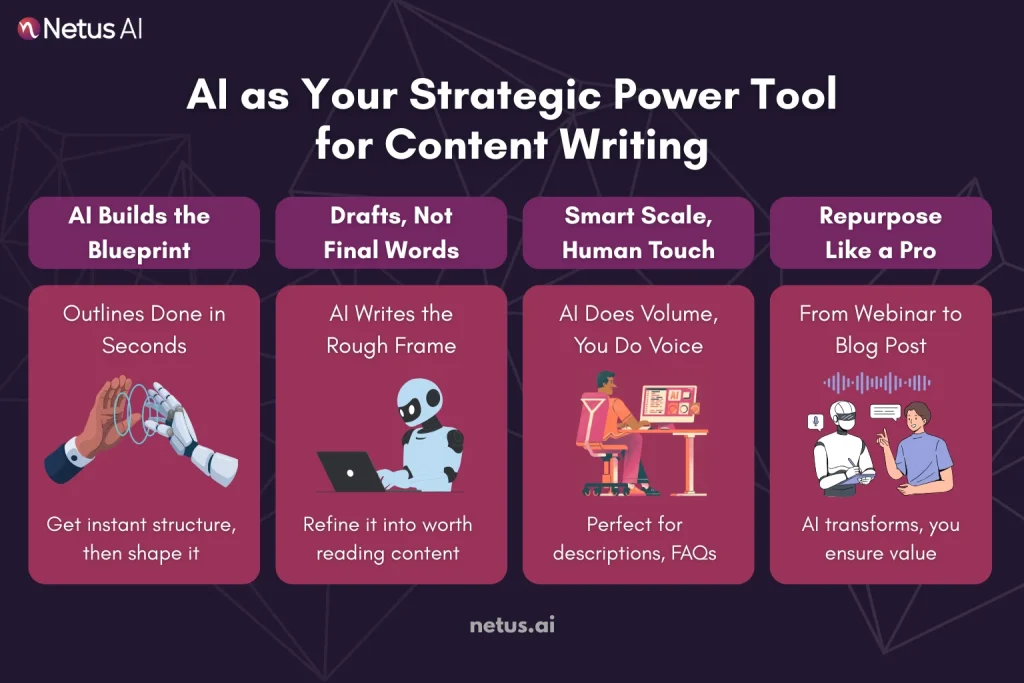
The successful SEOs and content teams in 2025 aren’t ditching AI. They’re wielding it with surgical precision, leveraging its undeniable strengths without letting it dictate the final product. Here’s where AI shines as an indispensable collaborator in SEO writing with AI:
The Architect: Staring at a blank page? AI excels at rapidly generating comprehensive, logically structured outlines based on target keywords, competitor analysis and user intent. Feed it a topic and a core query and it can suggest compelling H2s, H3s and even key points to cover under each. Take this skeleton and own it. Refine the flow, inject the unique angle, ensure it perfectly aligns with your brand’s expertise and audience needs. The AI provides the blueprint; you build the bespoke house.
The Drafting Assistant: Beating writer’s block? Generating a rough first draft based on your approved outline is AI’s sweet spot. It can quickly populate sections with relevant information, definitions and basic explanations. This draft is raw material, not publishable content. Your job is to humanize AI writing aggressively: rewrite sentences for natural flow and unique voice, delete fluff, add depth, challenge shallow assertions and infuse original insights, anecdotes and data. Think sculptor, not proofreader.
The Scalability Engine: Need hundreds of unique product descriptions, localized service pages or comprehensive FAQ sections? AI is incredibly efficient at generating variations on core templates at scale. Establish ironclad templates and brand voice guidelines first. Implement rigorous quality checks. Even for “lower-stakes” content, ensure factual accuracy, brand consistency and basic readability. Avoid sounding like a robot catalogue.
The Repurposing Maestro: Got a killer webinar, podcast or long-form report? AI can efficiently summarize, transcribe and reformat this goldmine into blog posts, social snippets, email newsletters or slide decks. Curate strategically. Don’t just repurpose everything; choose high-value pieces. Edit the AI output heavily to fit the new format and audience, adding fresh commentary or updates. Ensure it offers new value, not just repetition.
The Technical Sidekick: Crafting unique meta descriptions for thousands of pages? Generating basic schema markup? AI can handle these tedious, formulaic tasks efficiently. Provide clear parameters and review the output. Ensure meta descriptions are genuinely compelling click-magnets, not keyword-stuffed gibberish. Verify schema accuracy. AI does the heavy lifting; you ensure quality and relevance.
In these roles, AI acts as a powerful amplifier of human strategy and expertise. It handles the time-consuming, repetitive tasks, freeing you to focus on the high-value elements that actually move the needle: strategic direction, deep insight, authentic voice and rigorous quality control. This is AI SEO writing 2025 done right.
What Content Gets Penalized: The Fall from the Tightrope (Recognize the Danger Signs)
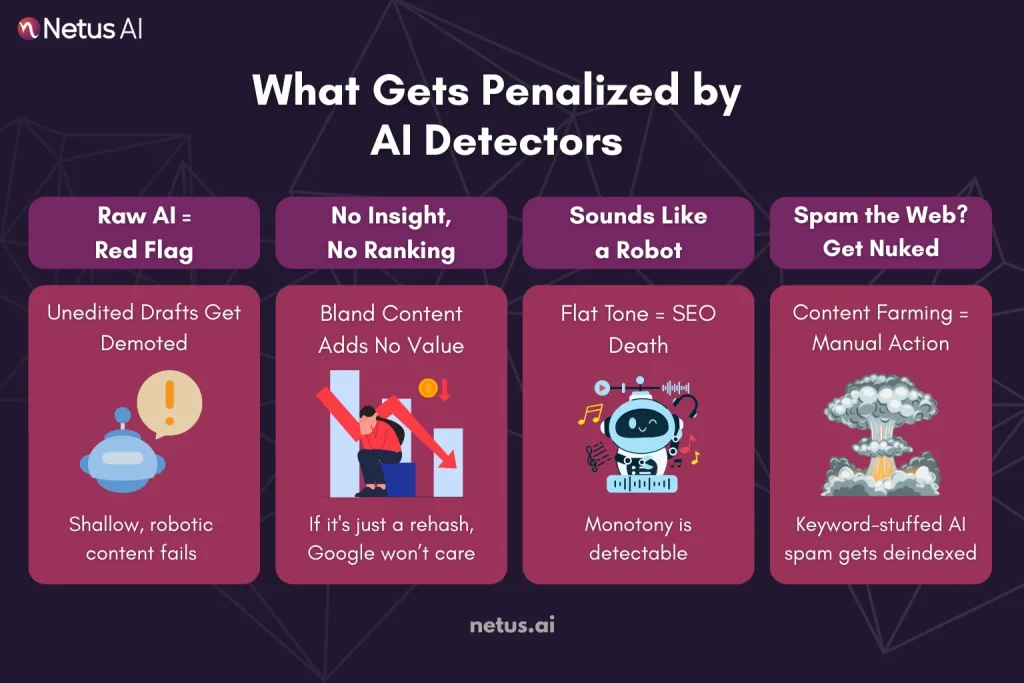
Now, the other side of the coin, the moves that will send you tumbling off that high wire in 2025. Google’s algorithms are finely tuned to detect and demote patterns synonymous with low-value, machine-first content. Here’s what triggers AI content penalties:
Publishing Thin, Unedited AI Output (The Cardinal Sin): This remains the fastest route to penalties. Hitting “publish” on raw AI drafts, no matter how fluent they seem, is professional malpractice in 2025. This content is inherently shallow, lacks originality, often contains subtle factual errors (“hallucinations”) and screams “ROBOT!” through its stylistic patterns. It offers zero EEAT and provides minimal user value beyond a basic keyword match. Google sees it as search engine fodder, not people-first content. Expect demotions, fast.
The Originality Vacuum: If your AI-generated blog post simply rehashes the same points found on the top 10 ranking pages, adding nothing new, no unique data, no fresh perspective, no case studies, no expert commentary, it’s dead on arrival. Google 2025 prioritizes content that demonstrably adds to the conversation. AI is a synthesizer, not an originator. Failing to inject genuine human expertise and unique insight results in content that’s instantly forgettable and algorithmically ignored.
Robotic Rhythms: Listen closely. Does your content have a relentless, mechanical cadence? Similar sentence lengths starting the same way? An overly formal or weirdly detached tone devoid of personality? This is stylometry in action, the statistical fingerprint of AI. Sophisticated detectors (and likely Google’s own evolving systems) spot these patterns instantly. It screams artificiality and disengages readers, leading to poor user signals (bounce rate, time on page) that further tank rankings. Humanizing AI writing means shattering this monotony.
Predictive Phrasing & Lexical Repetition: AI models have favorite crutches. Overuse of phrases like “it’s important to note,” “furthermore,” “in conclusion,” “this powerful tool,” or “unlock the potential” becomes a detectable signature. Similarly, unnatural repetition of specific nouns or verbs within a short span (a symptom of how AI predicts the next word) is a glaring red flag. These patterns create an uncanny valley feeling for readers and algorithms alike.
AI-Generated Spam & Content Farm Tactics: This is the nuclear option for penalties. Attempting to game the system by flooding the web with massive volumes of low-quality, keyword-stuffed AI content across thin affiliate sites or spammy blog networks will attract the most severe manual actions. Google’s spam teams are more adept than ever at identifying and nuking these networks. It’s not just demotion; it’s potential de-indexing.
The common thread? Content created primarily by AI for AI (search engines), lacking the essential infusion of human experience, expertise, editorial judgment and authentic connection. It fails the EEAT test spectacularly and provides a poor user experience. Google 2025 isn’t just looking for words on a page; it’s looking for value created by human minds, even if those minds used AI as a sophisticated tool.
Content Starts at Generation: NetusAI’s SEO Article Writer and Content Generator
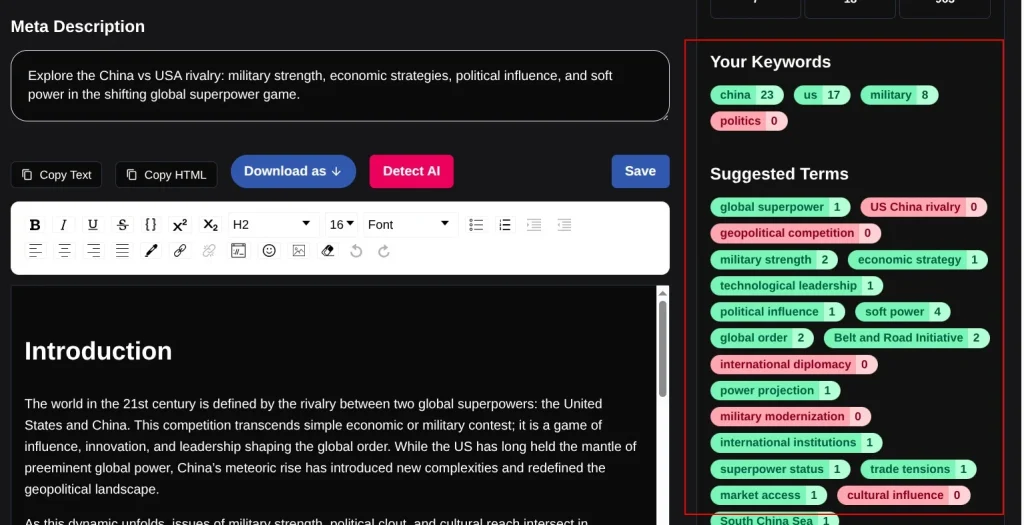
Avoiding stylometry and detection issues shouldn’t begin after content is written, it should start with the writing itself. That’s where NetusAI steps in.
Unlike generic AI tools that churn out robotic, easily flagged paragraphs, The NetusAI SEO Article Generator is designed to help you create full-length blog posts that are already optimized for clarity, tone and search intent. Unlike generic tools, it goes beyond simple drafting. It:
- Lets you input headlines and targeted SEO keywords
- Supports long-form templates for full blogs
- Auto-generates a structure with Title → Outline → Content
- Works in multiple languages for global teams
And most importantly: it ties directly into the Netus AI Bypasser + Detector system, meaning your output isn’t just readable, it’s already tuned to avoid detection.
You can generate, review and rewrite all in one interface without needing third-party tools to patch the gaps. It’s built for marketers, freelancers and bloggers who want their AI content to actually pass as human-written.
Alongside crafting human-first content, mastering core SEO practices is essential. Key must-dos include optimizing site structure, headings, and load times, which directly impact search performance and user experience. Tools like Ahrefs, Mangools, and Semush can help,, and for those looking for alternatives, this Semrush alternatives list can help you monitor performance and improve rankings.
Content Generator
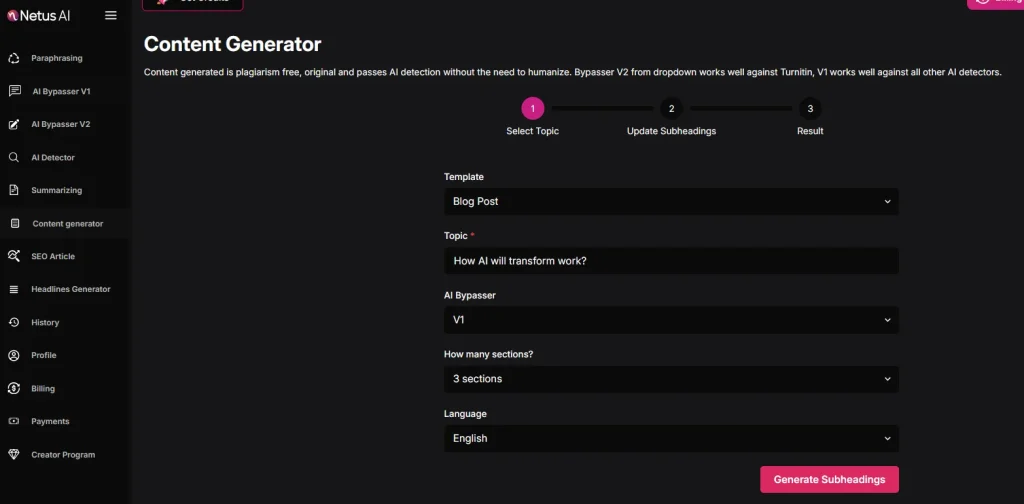
NetusAI also offers a Content Generator. Following the simple steps as shown on the user-friendly NetusAI page, Plagiarism Free Content will be generated from the beginning. The result generated can be downloaded and copied directly as well. Users can easily view their results as they will be stored in the history tab.
So whether you’re starting from scratch or turning an idea into a full SEO article, NetusAI saves you time and rewrites, without sacrificing trust or quality.
Final Thoughts
SEO writing with AI isn’t about hiding the tool, it’s about using it smartly. AI can save time, streamline workflows and scale content efforts, but raw outputs won’t survive Google’s growing scrutiny. The real win lies in humanized AI content, writing that maintains meaning, shows originality and feels authentic.
That’s why the smart play is hybrid creation, with NetusAI, you can:
Write with structure using the SEO Article Writer
Plagiarism free Content Generator
Detect and fix red flags with the AI Bypasser
Or you can start with AI, humanize with Netus AI, then finalize with human judgment. This approach gives you the speed of automation and the trustworthiness Google demands.
FAQs
Use AI to generate initial drafts, but always humanize the output. Edit for tone, flow and clarity, and run it through tools like NetusAI to ensure it’s undetectable and reader-friendly.
Yes, but only if it lacks value. Google penalizes thin, repetitive or obviously machine-written content. Humanized AI content that serves the user can still rank well.
Paraphrase smartly, break up patterns, inject real examples and test your content using AI detection tools. NetusAI helps streamline this with real-time feedback and rewriting.
Generic product pages, keyword-stuffed blog posts and templated service descriptions are common red flags, especially if left unedited.
Stylometry tracks writing patterns unique to AI models. Even good content can be flagged if it carries AI’s linguistic “fingerprint.” This is why structure-level rewriting is essential.
Absolutely. NetusAI offers a built-in SEO Article Writer, paraphraser and real-time AI detection, letting you write, humanize and test SEO blogs in one place.

